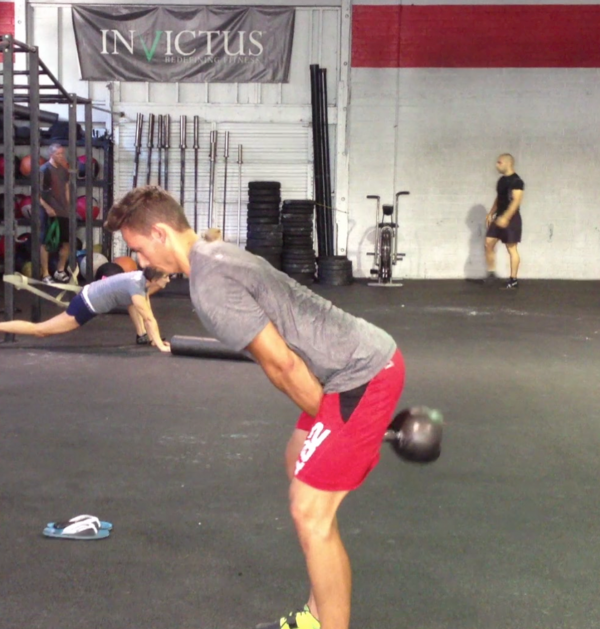
The Great Kettlebell Swing Debate
Written by C.J. Martin
Quite a few folks following our Competition programming have been wondering whether kettlebell swings should be performed as American Swings, Russian Swings or a hybrid. I have procrastinated an answer for long enough, so here it comes . . .
IT DEPENDS.
(I know, the least satisfying answer ever . . . but almost always the most accurate and best.)
Let’s take a look at the traditional American and Russian swings first, and then talk about how to determine which of those is best for you, or if there is a hybrid option that might work better.
Russian Kettlebell Swing
The Russian swing starts with the kettlebell just below the groin (above the knees) and is swung to chest level – approximately a 90-degree angle to the torso. The movement is short, brisk and compact. It is a hip-hinge movement, with roughly 20-degrees (or less) of flexion at the knee. The power of the swing is generated from the hips while the spine is held perfectly stable and neutral. At the apex of the swing, the bell is at chest level, and the athlete’s glutes are contracted, quads are engaged (pulling the knees up), belly is rock solid and braced for impact, and lats are actively pulling the shoulders away from the ears. Additionally, the Russian swing should be performed with rhythmic diaphragmatic breathing – filling the abdomen on the downswing and forcefully expelling through the teeth, while bracing the belly, at the top of the swing.
American Kettlebell Swing
The American swing should differ from the traditional Russian swing only in the finish position. The mechanics of the swing itself should be identical – the bell should pass just below the groin, there should be no more than 20 degrees of knee flexion, the hips should generate the power, the glutes should contract hard, the quads should engage to pull the knees up, and the belly should be rock solid. The difference is simply that the athlete will allow the force produced on the kettlebell to carry it all the way overhead so that the bottom of the kettlebell is directly over the ears, shoulders, hips and ankles. Note, athletes should not be increasing the amount of knee flexion (turning the movement into a squat), nor should they be lifting the kettlebell with their deltoids to assist it into the overhead position. The force is still generated solely by the hip drive, and if optimal force is produced by the hips the athlete will likely have to decelerate the kettlebell as it approaches its apex.
The Russian Swing Must Come First!
The first thing to understand is that the Russian swing must be the foundational movement. The American swing is a progression the builds from the foundation of the Russian swing. If you cannot perform Russian swings well, you will not perform American swings well. Attempting to jump straight to American swings without a solid understanding of the Russian swing often creates poor habits, like squatting through the movement or pulling up on the kettlebell with the traps and deltoids. So, we must start by mastering the short, concise, powerful Russian swing before attempting to move on to the American swing . . . or a hybrid.
My Hips Are Strong and My Swing is Solid . . . Can I Go Overhead?
My chief concern when training an athlete is to determine whether they can perform the assigned movements with perfect, virtuous mechanics. Without regard to the particular movement we are talking about, there are a few mechanical principles from which we should almost never deviate. Most notably, our movements should sequence in a wave of contraction from core to extremity, and we should be able to maintain a fixed (and typically neutral) posture.
Many athletes lack the mobility to achieve the range of motion required by the American swing. Restrictions in their thoracic spine and shoulder girdle often prevent them from raising their arms straight overhead with a completely fixed and neutral spine. These athletes typically compensate for their insufficient mobility by over-extending at the thoracic-lumbar junction. The example on the left demonstrates over-extension. You can see that compared to the photo on the right, Nichole’s ribcage is elevated and there is excessive curve at her lumbar spine.
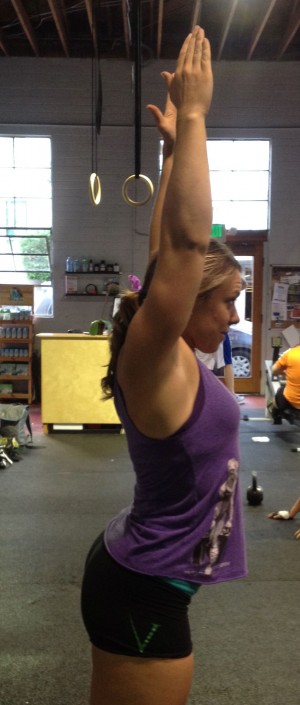
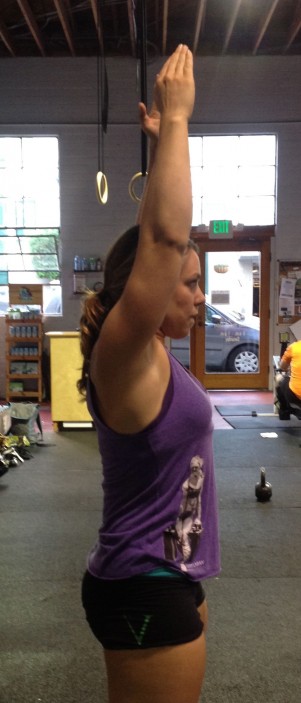
The answer to the question of whether you can or should be going overhead with your kettlebell swings is not one that I can answer from afar. That answer depends entirely on whether you have three things:
- The thoracic mobility to achieve the finishing position without overextending at the lumbar spine.
- The midline stability and coordination to achieve the finishing position without overextending at the lumbar spine.
- The discipline to achieve the finishing position without overextending at the lumbar spine.
It doesn’t take much for an experienced coach to determine whether an athlete meets the first two requirements . . . the answer to the third question will be answered once the athlete is challenged to maintain good mechanics despite gasping for air and fighting off fatigue. But just in case you do not have a good coach or training partner to help you determine if you have adequate mobility to perform American swings, here is a quick little tool to help you determine whether the overhead/American swing is right for you.
Step 1 – Lay down on your back with your chin and spine in a neutral position and your hands down at your sides.
Step 2 – Squeeze your bum and belly and at belly button level interlock your thumbs with your knuckles lined up – mimicking the position of your hands on the kettlebell.
Step 3 – Have a partner place their hand between your back and floor. (If you train alone, you can also stage your camera on the floor beside you and videotape this drill.) It’s likely (desirable, in fact) that there will be some space between your lower back and the floor. The more impressive your glute development (think Olympic-caliber sprinter), the larger that gap between back and floor will be.
Step 4 – Slowly begin to raise your hands from hip level to chest and eventually overhead until your knuckles touch the ground. Your partner will be there to determine if you change positions at any point. If the pressure on their hand decreases as you raise your arms (i.e., the space between your back and the floor increases) they will stop you. That is the height to which you should swing the kettlebell until you improve your thoracic mobility and/or midline stability.
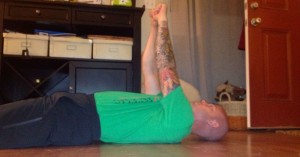
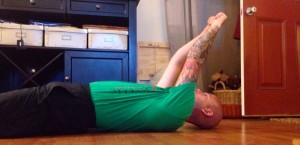
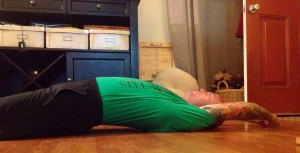
Hybrid Kettlebell Swing
I hope and assume that you all are able to pass chest level without losing a neutral spine position. But I am also guessing that not all of you got to the overhead position before you started to hinge and compensate with your spine. That point between Russian and American just before you start to lose your stable midline and neutral spine position is your unique version of the hybrid swing.
In our group sessions at Invictus, we will often suggest that most of our athletes swing the kettlebell to eyebrow height. This hybrid swing allows us to provide a common standard that can be met by the vast majority of our athletes. If the coach can see the athlete’s eyes under the bell, they’ve met the standard. It’s a compromise position that we have taken in group coaching, but for athletes training for competition, I want to see them swinging the kettlebell as high as they can without sacrificing good movement, a neutral spine and stable midline.
The Quick and Dirty Conclusion
You all might have a slightly different swing height for TRAINING. I am ok with that. If you’re training for health and fitness, determine which swing better fits your training goals for the given day, with the understanding that whichever method you choose must be performed with perfect mechanics.
For athletes out there looking to compete in the sport of CrossFit, I suggest swinging to the height that makes the most sense for you and your possible mobility restrictions until just a few weeks prior to the competition season. It will not take long to make the adjustment to American swings, and you will have enjoyed many months of training good mechanics. You will also buy yourself many months to work on your mobility so that when the competition season comes around you can repeat our little test and hit the full range on an American swing with perfect mechanics.
Thank you for the advice, it explained a lot about kettlebells.
if you can swing it over your head the kettlebell is too light.
I had a conversation with an Occupational Therapist. She explained that any movements above the shoulder increase the risk of shoulder injury. Something to keep in mind. If you have good control with the Russian swing, then interspersing some higher range swings (starting with less weight) could be an option for those who have the mobility in the shoulder joint and have already developed some good shoulder strength to ensure stability.
Forgot to mention the bastardized bent arm American swing every ones uses.
I did not see the fact addressed about what is going on with your shoulder joint when your hands are close together. The mobility test shows arms straight up like with the snatch. The ‘American swing’ has the hands over the head, not ear.
The Russian Swing is about projecting force forward, not upward. The hips hike backward, then thrust forward… unlike a squat there is no vertical component to the hip drive which is the reason why the Russian swing stops at chest level…its where the bell arrives at naturally when the arms are not used to pull the weight upward. If you use the same hip mechanics as in the Russian Swing to achieve the American swing then the only way to get the bell into the overhead position without dipping under is to use the arms to pull the weight upward… Read more »
John Mac,
Interested in your Box Jump reference as well. Could you explin a little more please.
thanks
Great thoughts in your article… I get my best rehab patients from the so called “american swing”. Its a fine method for creating those long term lower back injuries. I was baffled at where this method was actually coming from but when something is called “American” in fitness it usually means group exercise people needed a cheaper easier way to get a new class sold so the squat got removed from a proper kettle bell swing. Thats just my opinion but I get so many rehab folks from American swings and box jumps that those two things alone could keep… Read more »
This is hilarious. My Coach put a post of me on Instagram doing a conditioning circuit and we were doing the traditional style to the chest. So someone who also has “rehab” in his name ( so assuming he is a rehab specialist ), blasted me for not going overhead (full range of motion). First of all there are two distinct styles, Russian and the new “American” version. So going to chest is full range of motion for the traditional Russian style. I guess maybe he should go argue with Pavel or Mike Mahler, who popularized the move a decade… Read more »
Solid. Couldn’t ask for more here.
Good article.
Great article on discussing the Russian swing vs. the American swing. Most people I see doing the American swing (or claim to be doing it) use much more knee flexion. Hmm.. Well, no skin off my nose, because I’m doing the Russian swing.
Really solid and easy to follow advice and insight to the movement. The test is really usefull as well as I think alot of us tend to turn a blind eye to our inability to reach full range of motion overhead, with this it is hard to miss it. Thank you!
When I originally commented I clicked the “Notify me when new comments are added” checkbox and now each
time a comment is added I get three emails with
the same comment. Is there any way you can remove
people from that service? Cheers!
Great article, although not unique to kettlebell swings, right?
That broken position can (and does!) appear in anything overhead: presses, pullups, etc. And you can’t do “hybrid” presses or pullups, so in the long run you have to fix the position, not just alter your swing height.
I would have liked to see some recommendations or suggestions (mobility exercises, etc.) to this end.
Great article. I am new to CrossFit (1st week) but I don’t have anyone one to train with right now but I am looking for a gym. This helps me alot to gain a better understanding of the mechanics of the movement. Thanks…
I have a concern I love the workout but I think many people take it to the extreme some trainers do as many as 750 swings in 1hr isn’t this bad for you joints? repetitive moment with so much weight (35+)?
Monica: and the boredom of this Russian exercise! Enough to reduce your brain to that of a brutish Russian strongman. Enough to kill the joy of fitness training.
Really helpful.
Great KB article, thanks.
Great post CJ! I have a question though, as we were just having a debate about the swings. I think you covered it in this post, but just want to make sure. I have some athletes that started doing the swing more like a snatch movement. so with arms a little bent, swinging over head and then a tiny press overhead to make sure they have full extension of the arms. They argue that in competition, they can`t have straight arms all through the movement. Most of them all do the kb swing with straight arms and same mechanics as… Read more »
Thanks CJ!!